Our main research topic is the …
Xylem Vasculature of Plants
Plants are the tallest organisms on Earth – a feature supported by water-transporting xylem vessels in their vascular system. These cellular structures were a key development for terrestrial life on Earth to evolve. The xylem vessels are organized in interconnected tubular networks to enable water transport to the above-ground plant organs and to support plant stature. Whereas all plant cells are surrounded by flexible primary cell walls, xylem cells are massively reinforced by an additional, extremely stiff layer of a secondary wall. Better known in the form of biomass or wood, xylem walls are a major global sink for atmospheric carbon and contain the Earth’s most-abundant bio-polymer: cellulose. We are interested in the highly ordered patterns in which xylem walls are organized.

What is the selective advantage of these patterns and how are they made?
We want to understand how …
Microtubules Define cell Wall patterns
Microtubules are an important component of the plant cytoskeleton and essential for the development of complex wall patterns in xylem cells. In plant cells, microtubules are closely associated with the plasma membrane and form a network of ‘roads’ along which cellulose synthase complexes – the enzymes that produce cellulose – are migrating. Microtubules thus form a template for the subsequent deposition of cellulose and other cell wall material. However, most research on the role of microtubules during cell wall deposition has focused on primary walls, although neither patterned microtubule arrays nor patterned cell walls do occur here. For secondary walls, it is unknown how the patterning of the microtubule network is achieved, and whether microtubule-associated proteins accompany this process. We use novel in planta, in vitro, and in silico methods to unravel the proteins that underlie the patterning of the microtubule network.
Which molecules (proteins) control and aid microtubule patterning in developing xylem cells?
An essential part of our research is …
Live-Cell Microscopy of developing xylem
Until recently, it has been difficult to directly observe the development of xylem cells using high-resolution microscopy. This is because xylem cells develop deep inside a seedling, buried under several cell layers. To overcome this obstacle, we are using a novel genetic tool that allows to induce the formation of new xylem cells at the surface of a seedling where we can better study them with microscopes. We use Arabidopsis thaliana (thale cress), an inconspicuous weed and model plant for basic research, and have modified it so that we can specifically activate a master regulator of xylem development by adding a chemical. With this method, it is possible – for the first time – to observe xylem cells as they develop.
What is the molecular mechanism that ‘tells’ microtubules where to ‘go’?
CONTACT
University of Potsdam
Institute of Biochemistry and Biology (IBB)
Plant Physiology Department
Karl-Liebknecht-Str. 24-25, Haus 20
14476 Potsdam-Golm
Germany